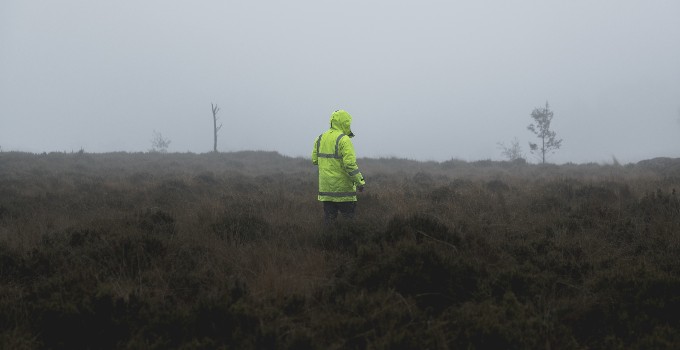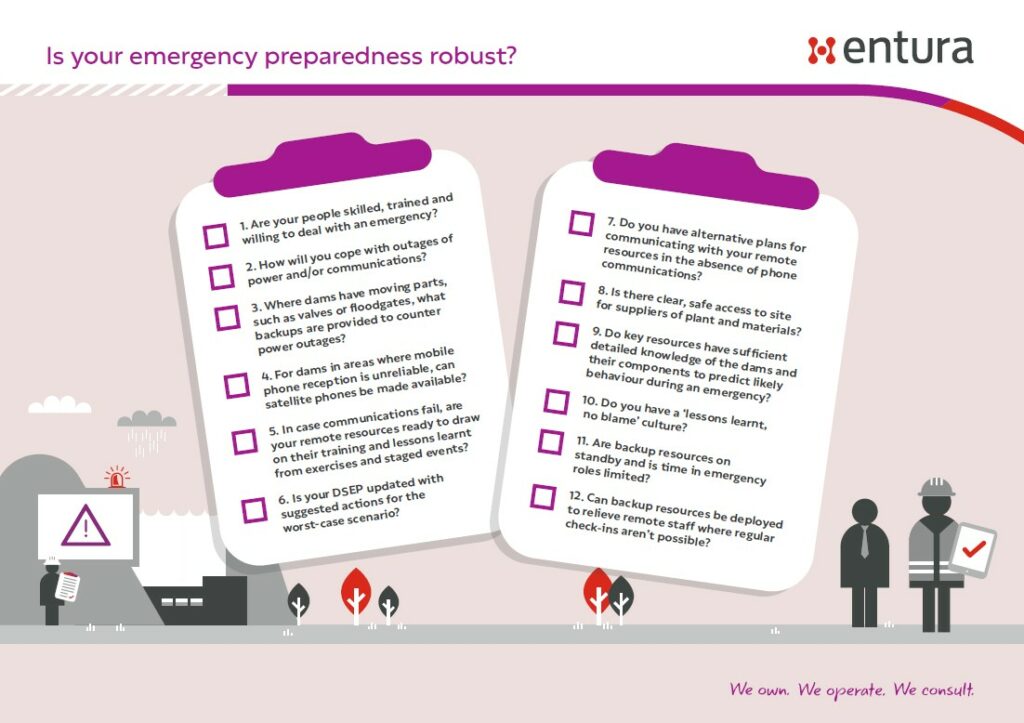THOUGHT LEADERSHIP
How robust is your emergency preparedness?

The old adage of ‘a company’s greatest assets are its people’ is never more true than in an emergency situation. The success of any emergency plan depends upon the skills, training and willingness of the people involved. It also relies on robust emergency preparation that takes as many scenarios as possible into account, and builds in a range of backups and alternatives for maximum agility and resilience.
All responsible dam owners have dam safety emergency plans (DSEP) which are carefully created and tailored to the needs of the company, its assets and its available resources.
If called upon in an extreme event, these plans will likely be pushed to their limit – but it’s vital that they perform as intended to reduce risk and consequences downstream.
The ultimate test of the emergency plan is how well it can cope with outages of power and/or communications. ‘Stress testing’ emergency plans for outage scenarios and implications is key to achieving a robust plan.
Power and communications outages
Where dams have moving parts, such as valves or floodgates, backups are needed to counter power outages. Are backup generators in place, or can a portable generator be brought to site at short notice? Is there a clear, safe access route to site during emergency conditions (e.g. not flooded or blocked by fallen trees)? Where this is not possible, can the valves or floodgates be operated by hand? A further question is whether these components are readily operable and exercised regularly.
Many dams are located in remote areas, and in some cases mobile phone reception is unreliable. In these situations, can satellite phones be made available? Landline phones may be available but depend on poles and lines remaining intact and operable during emergency conditions.
Communications are vital to ensuring the emergency plans are enacted under the direction of the incident controller. Where communications with remote resources are limited or not possible, those involved must fall back on their training and on lessons learnt from exercises and site-based, staged events involving scenarios of outages of power and communications. The DSEP can be updated with suggested actions for the on-site operators and emergency management team to follow in the worst-case scenario.
Alternative means of communication and access
In situations where check-in communications are required with those working remotely, alternative means must be considered in case of an outage of communications. In the absence of satellite phones, this could involve a messenger driving to site, but this relies on clear, safe access routes and careful consideration of the time required. In extreme cases, the only means of reaching a remote site may be by helicopter. This would require pre-arrangement with the closest helicopter providers regarding emergency availability.
The situation is similar with suppliers of plant and materials that may be required to assist with conditions at or downstream of the dam. How can they be contacted, and is there clear, safe access to site? Consider having emergency stockpiles at site or nearby and ready access to earthmoving plant.
Decision-making in a SCADA outage
If a power outage results in a localised SCADA outage, there will be no current instrumentation data available to guide critical decisions. In such circumstances, decisions must be based on likely behaviour during emergency conditions or on forecasts from before the emergency is declared. This would likely require detailed knowledge of the dams and their components, which highlights the importance of regular routine monitoring and detailed studies such as comprehensive surveillance reviews and dam safety reviews.
Company culture, teamwork and support
Where there is a ‘no blame’ company culture in which employees are encouraged to speak up, point out flaws in systems and processes and identify faults with assets, there is a greater likelihood that employees will participate successfully in staged exercises and events and provide useful information regarding how an incident response team will perform during an emergency.
Another important aspect of company culture is working together as a team. It is possible that a person may become fatigued but cannot convey this due to a communications outage. It is also conceivable that during an emergency a person may be unwilling to ‘leave their post’ until the job is done, becoming fatigued in the process.
It is important to have backup resources and to limit time in any role during the emergency to minimise the chance of mistakes being made. The emergency plan is only as strong as the weakest link in the chain of command.
For all resources, including external resources, provision of backups should take into account leave, prolonged illness and the need to ensure replacement when employees leave the company.
Where a company has a strong and positive safety culture and team ethos, detailed knowledge of its assets, regular inspection and exercising of valves and gates, and a commitment to team-based emergency training, employees are more likely to overcome the challenges posed by outages of power and communications during emergency conditions. They will find a way.
No one can predict and plan for every emergency scenario, but we believe that the tips we’ve shared here can help dam owners to develop and maintain robust emergency plans that have a higher likelihood of success when called into action.

If you would like support with your emergency planning, contact Richard Herweynen or Phillip Ellerton.
About the author
Jamie Cowan is a senior dams engineer at Entura with over 2 decades of civil engineering experience in the UK and Australia. His experience includes the management of investigation, design and construction projects in the civil, dams and water industries. He has worked across all stages of project delivery, from feasibility to the commissioning of assets. He has provided construction support roles during dam construction and upgrade projects, and conducted intermediate and comprehensive inspections of dams for water authorities in Victoria.
MORE THOUGHT LEADERSHIP ARTICLES
3 March, 2023






